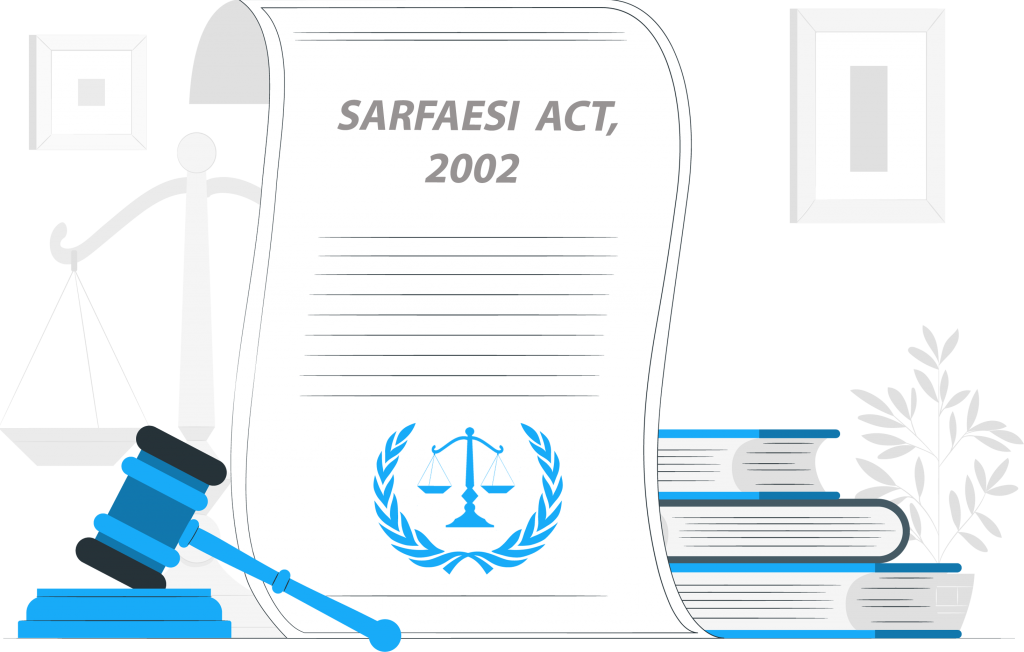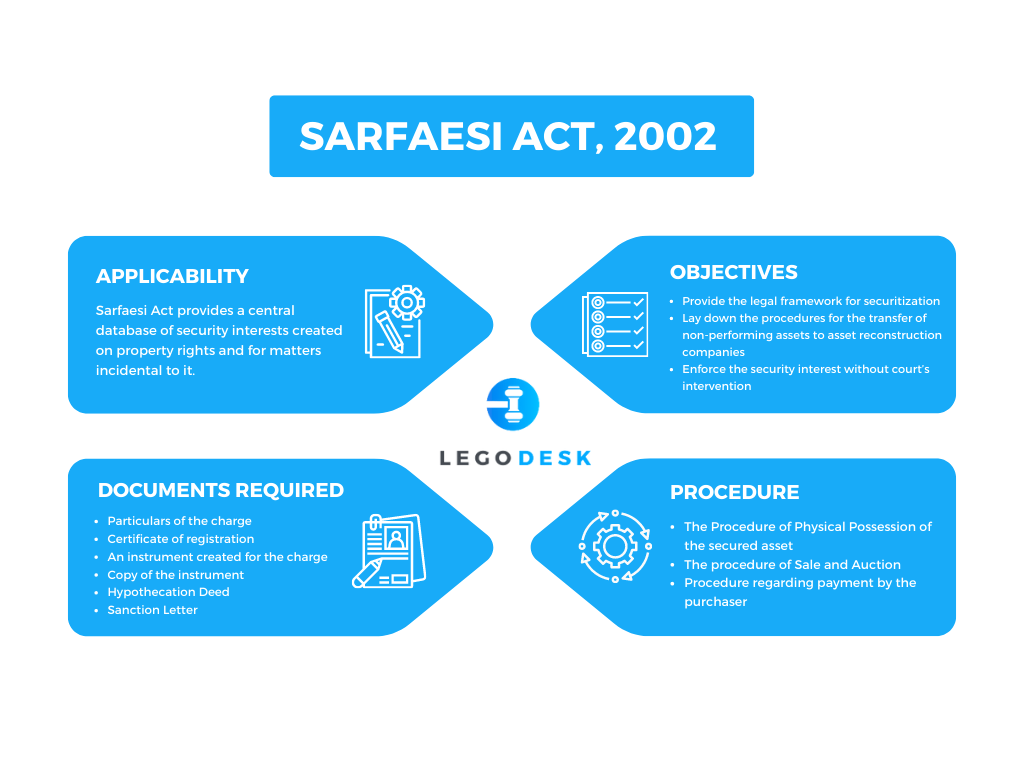SARFAESI ACT, 2002- Applicability, Objectives, Process, Documentation
(The Securitization and Reconstruction of Financial Assets and Enforcement of Security Interest) The SARFAESI Act 2002 became law on 22nd June 2002, and it regulates the securitization and reconstruction of financial assets, as well as the enforcement of security interests in them. For rapid recovery of non-performing assets. The central government constituted Narasimham Committee I and II and Andhyarujina Committee. Their purpose was to examine the banking sector reforms. The committees recommended forming new legislation for securitization and empowering banks and financial institutions to gain possession of the securities and to sell them without any court intervention. Sarfaesi covers the entirety of India.

Applicability
Sarfaesi Act provides a central database of security interests created on property rights and for matters incidental to it. The Act addresses the following:
- The Reserve Bank of India registers and regulates Asset Reconstruction Companies (ARCs).
- Facilitating the securitization of bank and financial institution financial assets, with or without the use of underlying securities.
- The ARC promotes the seamless transferability of financial assets by issuing debentures, bonds, or any other security that can be used as a debenture to acquire financial assets from banks and financial institutions.
- Any securitization or asset reconstruction company that is registered as a public financial institution with the Reserve Bank of India.
- ‘Security interest’ is defined as any sort of security, such as a mortgage or a charge on immovable property, issued in exchange for timely repayment of any financial aid provided by any bank or financial organization.
- The account of the borrower is classified as a non-performing loan.
Read Also – Just and Equitable Grounds in Indian Law
Objectives
The objectives of Sarfaesi are as follows:
- Provide the legal framework for securitization in India
- Lay down the procedures for the transfer of non-performing assets to asset reconstruction companies
- Enforce the security interest without court’s intervention
- Authorize banks and financial institutions to take over the immovable property (hypothecated or charged) to enforce the recovery of debt
- Ensure efficient or rapid recovery of non-performing assets of the banks and financial institutions
- Allow banks and financial institutions to auction properties when the borrower fails to repay their loans
Documents Required
For registration of creation and modification of charge, e-Form CHG-1 or e-Form CHG-9 is required to be filed. The documents required are as follows:
- Particulars of the charge
- Certificate of registration
- An instrument created for the charge
- Copy of the instrument (creating or modifying charge)
- Hypothecation Deed
- Sanction Letter
The following documents are required in case of e-form signed digitally:
- Digital Signature Certificate (DSC) of the charge holder
- Director Identification Number (DIN)
- Permanent Account Number (PAN) of the manager, CEO, CFO
- Membership Number of the Company Secretary

The Procedure of Physical Possession of the secured asset
If the borrower fails to repay the loan, the secured creditor is required to send a demand notice to the borrower to satisfy his obligations under section 13(2). This notice is valid for 60 days. The amount payable by the borrower must be specified in the demand notice, together with the sums due. The borrower can also object to the demand notice, which must be responded to by the secured creditor within 15 days, with the reply enumerating the reasons for the secured creditor’s refusal to accept the objection. The Supreme Court of India clarified this position and later added section 13 to the Sarfaesi Act. 1
See how Legodesk can help you with Legal Notice Tracking
If the Borrower does not discharge the debt within the 60-day term, the Secured Creditor can take the remedies listed below. Under section 13(4) the secured creditor can:
- take possession of the secured assets,
- take over the management of the asset,
- appoint any person to manage the secured asset.
These actions are appealable under sections 17 and 18 of the Act. The borrower can appeal the actions of the secured creditor in Debt Recovery Tribunal (DRAT) in High Court and Special Leave Petition in Supreme Court.
Read Also – Sending Legal Notice : Format and Procedure
The procedure of Sale and Auction
If the secured asset is being auctioned off, a sale notice is necessary if public tenders are being sought or if a public auction is being held. This sale notice must be published in two main newspapers, on the secured creditor’s website, and uploaded on tender.gov.in in accordance with the Ministry of Finance directives.
The Security Interest (Enforcement) Rules, 20022 require that the sale notice or possession notice be served effectively, i.e., in two newspapers in circulation in the area. The procedure for an auction of immovable assets is outlined in Rule 8 of the 2002 Security Interest (Enforcement) Rules. The following are some of the methods for selling immovable secured assets:
- receiving quotes from the individuals
- getting estimates from people who deal with similar secured assets or are otherwise interested in purchasing them
- inviting tenders from the public
- holding public auction
- private treaty
Procedure regarding payment by the purchaser
The primary step is to determine the reserve price i.e., the minimum fair market value of the immovable asset as set forth by the authorized officer. A relevant notice according to the obligations under Rule 8(6) must be sent. The bidding process for public auction shall be done in consonance with Rule 9. At the time of bidding the bidder shall deposit the earnest money. After the bidding is successful 25% of the accepted sales price has to be deposited. Lastly, 75% of the balance amount has to be deposited within 15 days of the said auction. After the aforementioned deposit has been made, a sale certificate is issued to the bidder. If the sale is done other than public auction, the sale shall be on terms and conditions as mutually agreed by the parties. 3 Further, the sale price should not be less than the reserved price.